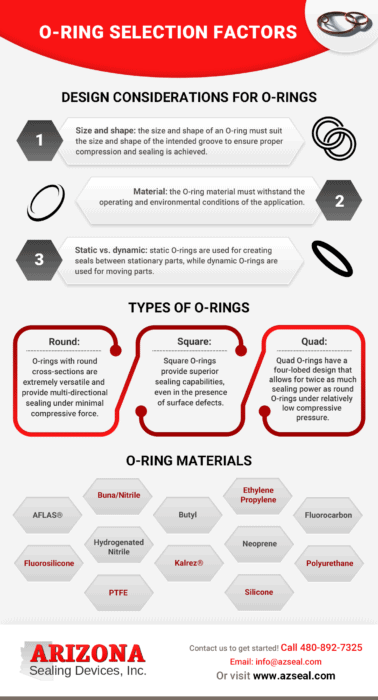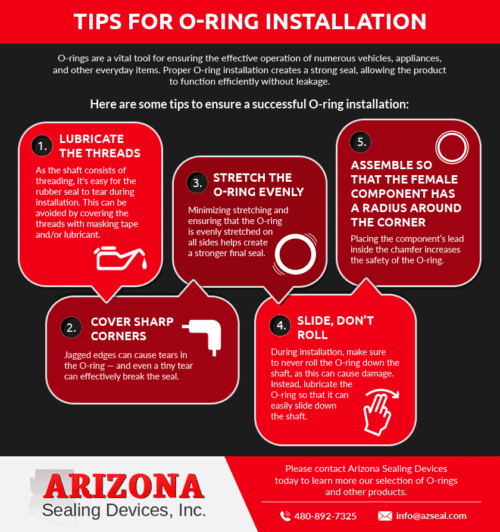O-Ring Materials Guide
Named for their standard circular shape, O-rings are versatile elastomer gaskets that form a tight seal between two mechanical components. However, while O-rings largely look alike and function similarly, there are actually key distinctions that determine where an O-ring may be used. Chief among these considerations is material selection. Despite their similar compositions, elastomers each have variations in their chemical and mechanical properties that influence how they perform at a given sealing task. When purchasing O-rings, it’s critical to consider your application’s needs and limitations rather than searching for a one-size-fits-all seal.
In this guide, we consider common O-ring materials in detail, including their strengths, limitations, and common applications. If you still have questions about after reviewing this material selection guide, we encourage you to contact our team at Arizona Sealing Devices, or browse our selection of O-rings.
O-Ring Materials: Strengths, Limitations, and Applications
At Arizona Sealing Devices, we work with a variety of elastomers to produce O-Rings. Here are the materials we use most frequently:
Buna-N/Nitrile
Among the most common elastomers used in O-ring manufacturing, Nitrile is a synthetic rubber unique for its chemical resistance properties. Whereas other rubbers often react with fuel and oil, nitrile is resistant to these substances, as well as many diluted acids and alkalines. As such, nitrile/Buna-N O-rings are the ideal choice for automotive, aerospace, and marine fueling. High tensile strength and thermal resistance enhance its utility in the aerospace and automotive industries. Despite its favorable chemical resistance characteristics, nitrile should not be exposed to ethers, esters, ketones, or chlorinated hydrocarbons.
Aflas®
Aflas is another elastomer that offers a combination of chemical, thermal, and electrical resistance properties, resisting acids, bases, and heat up to 446°F. Like nitrile, it is popular in oil, aerospace, and general industrial environments. However, Aflas should not be used in direct contact with automotive fuels because it swells more than comparable elastomers.
Butyl
Butyl is the classic choice for vacuum-sealing, providing extremely low permeability to gases. Its other benefits include resistance to ozone and sunlight, as well as good shock-dampening capabilities. Due to its shock-absorbing properties and chemical resistance, butyl is also used in hydraulics applications—especially those that use synthetic lubricants. However, ethylene propylene has largely supplanted butyl due to its enhanced durability.
Ethylene Propylene
A modern alternative to butyl, ethylene propylene exhibits low gas permeability alongside excellent heat, weather, and ozone resistance. These characteristics make it one of the most versatile elastomers for O-ring seals. Ethylene propylene is often used outdoors where weather resistance is a concern, as well as in automotive cooling and brake systems. The material’s primary limitation is a susceptibility to hydrocarbons.
Fluorocarbon (Viton®)
Offering outstanding chemical and high-temperature resistance, fluorocarbon O-rings are among the most durable and versatile available. They are particularly valuable in aircraft engines and automotive fuel handling systems because they resist swell in high-octane and oxygenated fuels. They also have improved resistance to amine-based oil protectants. Fluorocarbon’s primary limitation is an intolerance to low temperatures and certain chemicals, such as ketones, amines, low molecular weight esters, and ethers.
Fluorosilicone
Fluorosilicone is a saturated rubber with excellent extreme-temperature stability, making it a popular material in aerospace applications. Having both thermal and chemical resistance properties, fluorosilicone is also becoming popular for general-purpose O-rings, especially for outdoor applications. However, fluorosilicone is not a good choice for dynamic sealing of any kind due to its low strength and limited abrasion-resistance.
Hydrogenated Nitrile
Hydrogenating nitrile yields a more highly saturated chemical structure with correspondingly higher strength and chemical resistance. Hydrogenated nitrile O-rings perform well in oil- and fuel-handling applications, as well as general industrial use. Like nitrile, hydrogenated nitrile has excellent thermal properties, sealing at temperatures from -85°F to 350°F. Like standard nitrile, hydrogenated nitrile should not be used with ethers, esters, ketones, and chlorinated hydrocarbons.
Silicone Rubber
Although silicone is well-known for medical-grade and FDA-compliant sealing applications, silicone rubber is also a solid choice for extreme temperature static sealing due to its heat and cold resistance. Silicone rubber also holds up to weather, ozone, and acid exposure, although its low abrasion resistance limits its utility to static sealing applications.
Neoprene
Neoprene is an oil-resistant, weather-resistant, and ozone-resistant alternative to natural rubber that finds frequent use in the transportation industry. Resistant to Freon® and ammonia, neoprene is also a good choice for sealing refrigerators. As general O-ring material, however, neoprene is often cost-prohibitive compared to nitrile, which offers similar properties at a lower cost.
Polyurethane, Cast
Cast polyurethane stands out for its abrasion resistance, tensile strength, and shock absorption, though it also boasts resistance to many chemicals, including ozone, oils, and greases. Cast polyurethane O-rings offer excellent performance in high-pressure hydraulic systems, as well as in wheels and other dynamic systems. Polyurethane should not be exposed to strong acids, bases, or brake fluids, limiting some of its potential transportation applications despite the material’s capacity to carry heavy loads.
Polyurethane, Millable
Millable polyurethane is resistant to high-pressure hydraulic fluids, abrasion, oil, grease, cracking, and many chemicals. Like cast polyurethane, it does well under dynamic, heavy loads, even when used outdoors. Compared to cast polyurethane, it has a lower tensile strength and weakens at high temperatures.
Kalrez®
Kalrez features exceptional chemical resistance, and there’s virtually no industrial chemical that will cause it to degrade (although Kalrez O-rings will swell in the presence of certain solvents). Being nearly as inert as Teflon, Kalrez is one of the best options for chemical processing, oil and gas, and semiconductor manufacturing.
PTFE
PTFE yields some of the toughest O-rings on the market with an outstanding temperature range of -300° to 450°F. The trade-off is that PTFE is difficult to install, having very limited elastic memory and poor tear resistance. The latter property also means that PTFE should be limited to static loads or slow dynamic loads.
Quality O-Rings from Arizona Sealing Devices
Without extensive experience in sealing, it can be difficult to determine which elastomer is right for a given project. The experts at Arizona Sealing can help.
Arizona Sealing Devices, Inc. has extensive experience with all of these elastomers, and we take pride in matching our clients to the materials that will suit them best over time. An O-ring supplier since 1989, we have since become an ISO 9001:2015-certified distributor of a broader range of sealing products, including caps, gaskets, plugs, and seal kits. We’ve also worked with satisfied customers from virtually every industry, developing a nuanced understanding of the practical limitations of different sealing applications. As a result, our clients return to us again and again for guidance and reliable elastomer products.
To learn more about Arizona Sealing’s personalized service and extensive product line, request a quote today.







